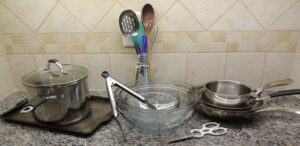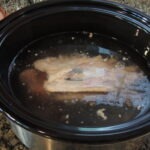Why is everything so complicated these days? Take salt, for example. We used to go to the grocery store and buy the easily recognizable cylindrical container of Morton’s salt. Everybody did. However, now we see shelves filled with various sizes, shapes and types. It can be confusing and difficult to decide what type of salt to buy. And does it even matter?
 We stressed over this issue, debating and researching. We learned more about salt than we ever imagined possible. Then came our next problem. How much information should we share with you before we confuse you entirely? Since you will probably buy only one, or maybe two types of salt, what should you choose? Sea salt, Himalayan salt, Celtic salt, natural salt, full-spectrum salt, Kosher salt, Morton’s salt…? We finally decided to simply specify “salt” in our recipes, except in the few cases where Kosher salt is preferable.
We stressed over this issue, debating and researching. We learned more about salt than we ever imagined possible. Then came our next problem. How much information should we share with you before we confuse you entirely? Since you will probably buy only one, or maybe two types of salt, what should you choose? Sea salt, Himalayan salt, Celtic salt, natural salt, full-spectrum salt, Kosher salt, Morton’s salt…? We finally decided to simply specify “salt” in our recipes, except in the few cases where Kosher salt is preferable.
In the meantime, here are some of the key points we learned. We’ll leave the decision-making up to you. (Skip to the bottom if you’re just interested in the bullet points.)
Let’s first discuss Kosher salt. The difference between Kosher and plain old Morton’s salt is the size and shape of the granule. Kosher salt granules are bigger and rougher, like snowflakes. It doesn’t clump as badly as refined table salt, so it doesn’t need anti-caking agents. Read the label to be sure, since some brands add them anyway. A teaspoon of Kosher salt will have less salt in it than regular table salt and even coarse ground salt. Rule of thumb—use a little less regular salt if the recipe calls for Kosher; use a little more Kosher salt if the recipe calls for regular. (1 teaspoon table salt = 1-1/4 teaspoons coarse Kosher salt.)
Kosher salt can be used in anything really. However, most baking calls for table salt, which is more finely ground and therefore blends in more smoothly than Kosher. We specify Kosher salt for Roast Chicken, although you can use regular table salt as well. Any salt on the skin will seal in the moisture of a chicken, but Kosher salt also creates a crunchy outer layer. Chefs like to use it because it’s easy to grab a pinch (due to the rough texture). We think it’s a good idea (but not necessary) to have a small container of Kosher salt around in addition to your everyday salt, especially since it’s not expensive.
Now let’s talk table salt. Morton’s salt (iodized or not) is what usually comes to mind. It is washed, purified and stripped of all minerals and other contaminates. It typically contains anti-caking additives, which may or may not bother you. It’s the cheapest salt, but since you really shouldn’t eat much salt anyway, the cost is not such a big factor. It will take you a long time to go through a pound of salt, so even buying an expensive salt will not break the bank.
Morton’s salt and other similar grocery store brands are produced in huge quantities by large scale manufacturers. They are highly refined, standardized to taste, and vacuum evaporated to speed up the production process. These operations are similar to our large industrial farms, which produce vast amounts of conventional crops (or often only one crop) on thousands of acres.
Sea salt is another common type of salt and one of the most confusing. First of all, you should know that even Morton’s table salt is mostly produced from seawater, so there’s no good reason to pay more for Morton’s refined sea salt, unless you just want a different (usually coarser) texture. Although many sea salts are less refined, produced in traditional ways, and have no added anti-caking agents, that’s not always the case. Morton’s sea salt is a good example of the latter, using the term simply for marketing purposes.
Earth salts come from salt mines that were once seawater, so they are also sea salt in a sense.
Now it’s time to discuss unrefined salts, like Himalayan, Celtic, full-spectrum and natural salts. These come from different sources and still contain trace minerals and other healthful contaminants like algae. They can be a little less salty due to higher levels of other minerals. Some people can taste the difference, but like fine wine, it takes a certain level of appreciation. Many top chefs and home cooks use artisanal salts, hand-crafted in small batches to impart unique indigenous flavors. If you like to support small farmers, you might also want to purchase some artisanal salts that reflect the character of a particular region. (For example, fleur de sel from Brittany, France or Hawaiian alaea salt.) Check out some of the specialty spice and gourmet stores to learn more.
 Although the level of trace minerals in unrefined salt is tiny, we like the idea of using foods as close to nature as possible, so we try to buy unrefined salt if we can. For everyday use we currently like Real Salt from Utah. It’s finely ground and easy to use in all applications. Yes, it’s more expensive, but an $8 container will still probably last at least a couple of years, so we don’t worry about it too much. However, feel free to buy Morton’s salt if you’re not a connoisseur of fine salt and only want to spend $1. Most people won’t notice.
Although the level of trace minerals in unrefined salt is tiny, we like the idea of using foods as close to nature as possible, so we try to buy unrefined salt if we can. For everyday use we currently like Real Salt from Utah. It’s finely ground and easy to use in all applications. Yes, it’s more expensive, but an $8 container will still probably last at least a couple of years, so we don’t worry about it too much. However, feel free to buy Morton’s salt if you’re not a connoisseur of fine salt and only want to spend $1. Most people won’t notice.
Flavored salts are just for fun. If you can afford them, go for it! Just remember to go easy on salt. You can have too much of a good thing. However, once you start cooking more and more of your own meals, you’ll most likely reduce your sodium (salt) intake dramatically even with the extra sprinkling of chipotle lime sea salt!
Although salt should be used sparingly, don’t forget that salt is vital to our health. Salt contains sodium, which is necessary for proper water and electrolyte balance, as well as nerve and muscle function. However, the recommended amount is only about 1 teaspoon per day, total! By preparing and salting your own foods, you can regulate your intake much better. Always salt foods with a small amount while cooking, keeping in mind the possible salt content of your ingredients (like broth or canned beans), then add more to taste before serving, if needed.
STORING SALT:
Proper storage of salt depends on the type. Most traditional salts do not have much moisture and can be stored in the cardboard container in which they are purchased. Specialty salts that are considered “moist,” like fleur de sel and sel gris, should be stored in airtight, glass containers. Read the labels, which normally give instructions for storage.
BOTTOM LINE: Your choice of salt is really up to you. Use the tips below to help you choose.
- When the recipe calls for salt, most any type will do, but the amount might need to be adjusted.
- Table salt is the cheapest, produced by large industrial conglomerates.
- Kosher salt is fluffier and rougher. Good for creating a crusty outer layer. Contains less salt per teaspoon than table salt. (1 teaspoon table salt = 1-1/4 teaspoons coarse Kosher salt)
- If you want to cut out additives, look for unrefined salt or certain sea salts (read the label).
- Specialty salts can add an extra punch to foods and can be fun to experiment with, if you’re into that.
- Artisanal salts support small, community producers, if you’re into that. If you don’t eat iodized salt, make sure you get it in your diet through an iodine supplement, kelp, or by eating seaweed (which can be added to soups and salads).

